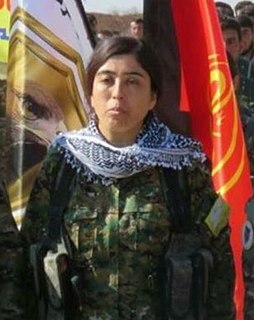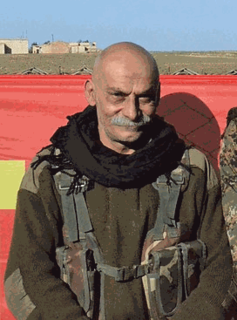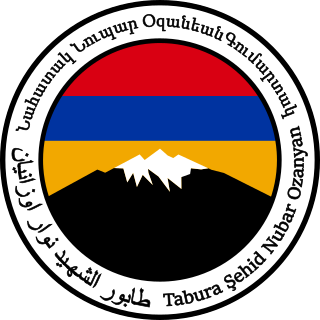
The People's Protection Units or People's Defense Units is a mainly-Kurdish militia in Syria and the primary component of the Syrian Democratic Forces (SDF). The YPG mostly consists of ethnic Kurds, but also includes Arabs and foreign volunteers; it is closely allied to the Syriac Military Council, a militia of Assyrians. The YPG was formed in 2011. It expanded rapidly in the Syrian Civil War and came to predominate over other armed Kurdish groups. A sister group, the Women's Protection Units (YPJ), fights alongside them. The YPG is active in Northern and Eastern Syria.

The Syriac Military Council is an Assyrian/Syriac military organisation in Syria, part of the Syrian Democratic Forces. The establishment of the organisation was announced on 8 January 2013. According to the Syriac Military Council, the goal of the organisation is to stand up for the national rights of and to protect Assyrian/Aramean people in Syria. It operates mostly in the densely populated Assyrian areas of Al-Hasakah Governorate, and is affiliated to the Syriac Union Party.

The Syrian Kurdish–Islamist conflict, a major theater in the Syrian Civil War, started after fighting erupted between the Kurdish People's Protection Units (YPG) and Islamist rebel factions in the city of Ras al-Ayn. Kurdish forces launched a campaign in an attempt to take control of the Islamist-controlled areas in the governorate of al-Hasakah and some parts of Raqqa and Aleppo governorates after al-Qaeda in Syria used those areas to attack the YPG. The Kurdish groups and their allies' goal was also to capture Kurdish areas from the Arab Islamist rebels and strengthen the autonomy of the region of Rojava.

Euphrates Region, formerly Kobanî Canton,, is the central of three original regions of the de facto autonomous Autonomous Administration of North and East Syria, factually comprising Ayn al-Arab District of the Aleppo Governorate, Tell Abyad District of the Raqqa Governorate, and the westernmost tip of Nahiya Ras al-Ayn of the Ras al-Ayn District of Al-Hasakah Governorate. Euphrates Region unilaterally declared autonomy in January 2014 and since de facto is under direct democratic government in line with the polyethnic Constitution of Rojava.

The Women's Protection Units or Women's Defense Units is an all-female militia involved in the Syrian civil war. The YPJ is part of the Syrian Democratic Forces, the armed forces of Rojava. While the YPJ is mainly made up of Kurds, it also includes women from other ethnic groups in Northern Syria.

The foreign relations of the Autonomous Administration of North and East Syria refers to the external relations of the self-proclaimed autonomous region of the Autonomous Administration of North and East Syria. The region, consisting of three regions was formed in early 2014 in the context of the Syrian Civil War, a conflict that has caused the involvement of many different countries and international organizations in the area.

The International Freedom Battalion, commonly abbreviated as IFB or EÖT, is an armed group consisting of leftist foreign fighters fighting for the People's Protection Units in the Syrian Civil War in support of the Rojava Revolution and against the Islamic State of Iraq and the Levant, the Turkish Armed Forces, and the Turkish-backed Free Syrian Army. The formation of the IFB was announced in June 2015 in Serê Kaniyê. Inspiration for the group came from the International Brigades of the Spanish Civil War. The political ideologies of the fighters include Marxism–Leninism, Hoxhaism, Maoism, and anarcho-communism.

The Kobanî massacre was a combination of suicide missions and attacks on Kurdish civilians by the Islamic State of Iraq and the Levant on the Kurdish-held city of Kobanî, beginning on Thursday, 25 June, and culminating on Friday, 26 June 2015. The attacks continued into 28 June, with the last remaining ISIL militant being killed on the following day. The attacks resulted in 223–233 civilians dead, as well as 35–37 Kurdish militiamen and at least 79 ISIL assailants. It was the second-largest massacre committed by ISIL since it declared a caliphate in June 2014.
Relations between the People's Protection Units (YPG) and the Free Syrian Army (FSA) are unclear and varied among the different FSA factions. Both are opposed to the Islamic State of Iraq and the Levant. However, several clashes have taken place. Under pressure from the United States, some FSA groups coordinate with the YPG to battle ISIL under the name of the Syrian Democratic Forces, although some other FSA groups remained in conflict with the YPG and the SDF, including FSA groups in the SDF.

The Syrian Democratic Forces is an alliance in the Syrian Civil War composed primarily of Kurdish, Arab, and Assyrian/Syriac militias, as well as some smaller Armenian, Turkmen and Chechen forces. The SDF is militarily led by the People's Protection Units (YPG), a mostly Kurdish militia. Founded in October 2015, the SDF states its mission as fighting to create a secular, democratic and decentralized Syria. The updated December 2016 constitution of the Autonomous Administration of North and East Syria (NES) names the SDF as its official defence force.

The Forces of the Brave, generally called the al-Sanadid Forces, are a militia formed by the Arab Shammar tribe to fight against the Islamic State of Iraq and the Levant. Even though tribe's Syrian strongholds are mostly in the Jazira Canton of Rojava, such as at al-Yaarubiyah and Tell Hamis, the militia operates throughout most of Rojava. The red colour in their flag represents blood while the yellow represents the light, calling themselves “marchers on the red death”. The al-Sanadid Forces are affiliated with the co-governor/co-president of Jazira Canton and tribal leader Humaydi Daham al-Hadi, and are led by Humaydi's son Bandar al-Humaydi.

The Battle of Tel Abyad was a raid by the Islamic State of Iraq and the Levant on the YPG-held town of Tell Abyad at the end of February 2016, during the Syrian Civil War.

The Manbij offensive, code-named Operation Martyr and Commander Faysal Abu Layla by the SDF, was a 2016 military offensive operation by the Syrian Democratic Forces (SDF) to capture the city of Manbij from the Islamic State of Iraq and the Levant (ISIL), and eventually, the ISIL-held areas through Al-Bab to Herbel, in the area referred to as the "Manbij Pocket" in the northern Aleppo Governorate. The main goal of the offensive was to cut off ISIL's last supply routes from Turkey, and to prevent ISIL fighters from escaping across the border. During the first 5 days of the offensive, the US-led coalition conducted over 55 airstrikes in support of the SDF. After capturing Manbij city on 12 August, the SDF announced that the offensive would continue until the whole countryside around Manbij was captured, though the offensive effectively ended shortly after Turkish-backed forces started Operation Euphrates Shield.

Rojda Felat is a Syrian Kurdish top commander of the Women's Protection Units (YPJ) and Syrian Democratic Forces (SDF), who fights since 2011 for Rojava in the Syrian Civil War, and has led several major campaigns against the Islamic State of Iraq and the Levant (ISIL). A revolutionary feminist, Felat's stated goal is to achieve social transformation in the Middle East through the YPJ, "liberating the Kurdish woman and the Syrian woman in general from the ties and control of traditional society, as well as liberating the entirety of Syria from terrorism and tyranny".

The Anti-Terror Units are the special forces of the Syrian Democratic Forces, consisting of the best trained and equipped members of the People's Protection Units (YPG) and Women's Protection Units (YPJ). They were led by the Syrian Kurdish commander Ali Boutan until his death. YAT is trained by United States special operations forces and the CIA.

Nubar Ozanyan was a Turkish-born Armenian radical communist revolutionary, who served as a commander in the militant Communist Party of Turkey/Marxist–Leninist (TKP/ML). Fighting in several conflicts for the group, he eventually died in combat against the Islamic State of Iraq and the Levant during the Battle of Raqqa.

Lorenzo Orsetti, also known as Orso and Tekoşer Piling, was an Italian anarcho-communist and antifascist from Florence who fought with the Kurdish People's Protection Units (YPG) in Syria.

The Martyr Nubar Ozanyan Brigade is an Armenian military organization in Syria and a part of the Syrian Democratic Forces. The brigade was founded in the Marziya Church in Tell Goran on 24 April 2019, the 104th anniversary of the Armenian Genocide.

The Martyrs' Cemetery is in Kobanî, in the Rojava region of Syria. It was established in 2012 and is used for the members of the Syrian Democratic Forces (SDF) killed during the Rojava conflict, part of the Syrian civil war. Many of the defenders killed during the siege of Kobanî against the Islamic State of Iraq and the Levant (ISIL) are buried here. By 2019, approximately 1300 had been buried at the cemetery.




















